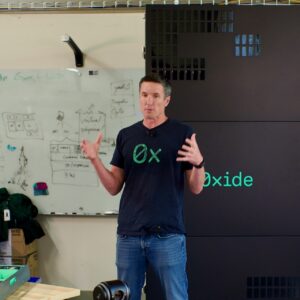|
|
 |
This Presentation date is June 14, 2024 at 9:00-10:30.
Presenters: Bryan Cantrill, Steve Tuck, Travis Haymore
Who is Oxide Computer Company?
Watch on YouTube
Watch on Vimeo
The Oxide founders experienced the challenges of managing on prem cloud infrastructure firsthand – their pains alchemized into Oxide. The team consists of leading technologists specialized across the stack (from companies like Sun, Meta, Amazon, Google, etc.).
Oxide Computer Company was founded in 2019 by Steve Tuck and Bryan Cantrill, who previously worked together at Joyent, a cloud computing company. Their mission is to bring the benefits of cloud computing architecture, such as elastic infrastructure services and API-driven automation, to on-premises environments. They believe that cloud computing should not be limited to public clouds but should be ubiquitous, available to enterprises that still maintain significant IT infrastructure outside the public cloud. The founders’ experience at companies like Dell and Sun Microsystems informed their understanding of the challenges and inefficiencies in the current market, leading them to create a solution that integrates hardware and software into a unified product.
The team at Oxide is composed of top-tier technologists from various leading companies such as Sun, Meta, Amazon, and Google, covering the entire stack from hardware to software. This diverse expertise allows Oxide to take a holistic approach to designing their cloud computer, ensuring that every layer is optimized and integrated seamlessly. The company has embraced a remote-first model, which has enabled them to attract talent from around the world, including experts from the GE medical team and other specialized fields. This diverse and highly skilled team is the nucleus of Oxide, driving their ambitious goal of revolutionizing on-premises cloud computing.
Oxide’s focus is on the large enterprise and cloud SaaS markets, with significant interest from the federal sector and financial services. These sectors require the automation and developer tooling provided by cloud-native architectures but need to maintain control over their data and applications due to security, latency, and regulatory requirements. Oxide’s transparent approach, including sharing their software on GitHub and discussing their journey on the “Oxide and Friends” podcast, reflects their commitment to openness and innovation. Their partnerships with key suppliers, like Sanyo Denki, have enabled them to co-design high-efficiency systems, further enhancing their products’ performance and reliability.
Personnel: Steve Tuck
What is the Oxide Cloud Computer?
Watch on YouTube
Watch on Vimeo
The Oxide Cloud Computer is a vertically integrated platform built at rack-scale for efficiency and operational benefits, with a control plane for elasticity and multi-tenancy, and with networking built in.
The Oxide Cloud Computer is a vertically integrated platform designed to bring the efficiencies and operational benefits of hyperscale cloud infrastructure to on-premises environments. Unlike traditional enterprise IT setups, which require piecing together hardware from various vendors and dealing with integration and maintenance complexities, Oxide offers a rack-scale solution that integrates hardware, software, and networking from the ground up. This approach is inspired by the design principles of cloud hyperscalers, who have moved away from the “kit car” approach of assembling individual servers and instead build at the rack level for better density, energy efficiency, and operational simplicity.
A key feature of the Oxide Cloud Computer is its focus on an API-first mentality, which simplifies automation and management tasks. By building their own switch and incorporating a fully programmable network stack using P4, Oxide ensures that the entire system is optimized for performance and observability. This allows for advanced features like delay-driven multipath routing, which constantly optimizes packet paths based on real-time latency data. Furthermore, the system’s hardware and software are co-designed to work seamlessly together, enabling capabilities such as dynamic power orchestration and power capping, which are crucial for managing energy efficiency and addressing power constraints in data centers.
The Oxide Cloud Computer also emphasizes ease of use and scalability. The system features blind-mate server sleds that can be easily added or replaced without the need for complex cabling, reducing the time and effort required to scale up capacity. This design allows for quick deployment and minimizes downtime, enabling developers to be productive within hours of installation. Additionally, the platform includes an elastic storage service and a set of networking and security services akin to those found in public clouds, providing a familiar and powerful environment for developers. By offering a CapEx model with a support subscription for updates and maintenance, Oxide aims to deliver a cost-effective and long-lasting solution for on-premises cloud computing.
Personnel: Steve Tuck
What Does Oxide Value Mean to Oxide Computer Company?
Watch on YouTube
Watch on Vimeo
Oxide offers the values that hyperscaler infrastructure offers, but on prem. This is in sharp contrast to existing on prem solutions, which is cobbled commodity infrastructure from disparate vendors – a result of market capture, not innovation. By codesigning like the hyperscalers, Oxide offers a rack-scale system it takes complete responsibility for – a system that is robustly supportable/debuggable, and open-source.
Oxide Computer Company, co-founded by Bryan Cantrill, aims to deliver the robust infrastructure benefits of hyperscalers but for on-premises environments. Unlike traditional on-prem solutions that rely on pieced-together components from various vendors, Oxide’s approach involves a holistic co-design of hardware and software, similar to hyperscalers like Google and Amazon. This co-design allows Oxide to offer a rack-scale system that is highly supportable, debuggable, and built on open-source principles. Cantrill emphasizes that this integrated approach solves many of the inefficiencies and complexities that have historically plagued on-prem systems, which often require significant manual intervention and suffer from poor inter-vendor integration.
Reflecting on the evolution of computing infrastructure, Cantrill notes that the initial on-prem era required extensive manual setup and maintenance. The rise of cloud computing in the mid-2000s, facilitated by advancements in internet ubiquity, open-source software, and commodity hardware, allowed hyperscalers to innovate rapidly. However, this led to a divide where only hyperscalers could leverage modern, efficient infrastructure, leaving traditional on-prem systems outdated and inefficient. Oxide aims to bridge this gap by offering on-prem solutions that bring the same level of efficiency and innovation found in hyperscaler environments, but with the added benefits of ownership, compliance, and localized control.
Oxide’s unique value proposition lies in its ability to offer a fully integrated system where both hardware and software are designed to work seamlessly together. This integration not only enhances performance and reliability but also simplifies support and troubleshooting. Cantrill highlights that Oxide’s commitment to transparency, open-source development, and deep partnerships with suppliers enables them to solve complex supply chain issues and deliver a resilient product. By focusing on engineering rigor and first principles, Oxide ensures that their systems are not only high-performing but also highly supportable, providing a delightful customer experience. This approach allows Oxide to meet the needs of enterprises that require the flexibility and control of on-prem solutions without sacrificing the innovations and efficiencies of modern cloud infrastructure.
Personnel: Bryan Cantrill
Oxide Cloud Computer Customer Use Cases
Watch on YouTube
Watch on Vimeo
Steve Tuck discusses some of Oxide’s key customer segments, across federal, financial, and cloud SaaS players.
Steve Tuck, co-founder and CEO of Oxide Computer Company, presented at Cloud Field Day 20, focusing on the diverse customer segments that are leveraging Oxide’s solutions. These segments include federal agencies, financial services, and cloud SaaS companies, each with unique needs and challenges. For instance, federal agencies are undergoing initiatives like the Digital First Public Experience, which aims to digitize a significant portion of government documents. These agencies often deal with on-premises IT infrastructures, and the introduction of Oxide’s cloud computing appliances has allowed them to streamline operations significantly. For example, tasks that once took months can now be accomplished in hours, leading to increased efficiency and effectiveness in handling projects.
In the federal space, Oxide’s solutions have been particularly transformative. One federal agency shared an anecdote about how their highly skilled security engineers were spending 60% of their time on tasks like VMware license management and BIOS updates instead of focusing on critical security projects. By deploying Oxide’s appliances, these engineers could redirect their efforts towards more impactful work, thereby increasing the agency’s overall productivity. The deployment process itself has been straightforward, with Oxide racks integrating seamlessly into existing environments and providing enhanced telemetry and visibility. This has been especially beneficial for networking teams, who can now quickly identify and resolve issues, leading to a smoother and more efficient operation.
Cloud SaaS companies and financial services firms are also finding significant value in Oxide’s offerings. For cloud SaaS companies, the ability to extend their platforms beyond the public cloud to reach more data and provide better performance has been a game-changer. For example, an e-commerce company using Oxide’s solutions can reduce latency and improve customer experience by deploying their platform closer to customer assets. Similarly, financial services firms are moving away from DIY infrastructure to focus on building financial products, leveraging Oxide’s API-driven, cloud-like operations to simplify their IT environments. Overall, Oxide’s solutions are enabling these organizations to achieve greater efficiency, transparency, and performance, making it an attractive option across various industries.
Personnel: Steve Tuck
Oxide Computer Company Console Demo and VM Provisioning
Watch on YouTube
Watch on Vimeo
Travis demonstrates the Oxide console and deploys multiple virtual machines (utilizing Terraform). He covers silos, images, projects, and instances as well.
Travis Haymore from Oxide Computer Company presented a detailed demonstration of their console and virtual machine (VM) provisioning capabilities during Cloud Field Day 20. He began by providing an overview of their co-location environment, specifically highlighting a rack deployed in the CoreSite data center in Milpitas. This rack serves multiple purposes, including internal use, customer demos, and evaluations. Haymore introduced the concept of “silos” as a means of achieving multi-tenancy, where resources such as CPU, memory, and storage are logically and cryptographically separated. Each silo has a distinct API endpoint, ensuring a clear demarcation between different users or customers.
In his demo, Haymore showcased the process of creating and managing projects within a silo. Projects act as logical containers for different efforts within an organization, allowing for varied configurations and user privileges. He demonstrated how to create a new project, manage instances, disks, snapshots, and images, and configure virtual private clouds (VPCs) and floating IPs. Using the UI, he provisioned a VM by selecting the necessary resources and an operating system image, in this case, Ubuntu. He emphasized the ease of passing SSH keys via Cloud-Init for immediate access to the instances, which is particularly useful for teams needing quick and secure access.
Haymore also touched on more advanced configurations, such as attaching external storage and managing network interfaces. He highlighted the flexibility of the system, noting that while many customers prefer using the API, CLI, or Terraform provider for automation, the UI remains a useful tool for less sophisticated users. The demo concluded with an example of using Terraform to automate the provisioning of multiple instances, demonstrating the system’s responsiveness and ease of use. Haymore also discussed the future potential for expanding storage and memory within the rack, and the possibility of integrating different hardware profiles to meet specific needs, emphasizing Oxide’s commitment to flexibility and scalability in their cloud computing solutions.
Personnel: Travis Haymore









